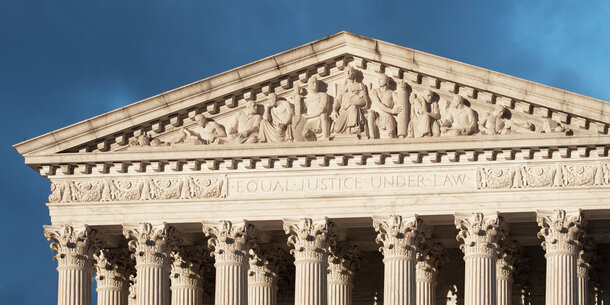President Donald Trump will exit the White House having left his imprint up and down the federal bench. A slew of young and deeply conservative judges will shape district and appellate courts — and American life — for a generation or more to come. No less remarkable is that Trump named three justices to the Supreme Court, and that each nomination was mired in controversy and secured only by a narrowly partisan Senate vote.
This has thrust debate about the Supreme Court into the public square, where it became a hot-button topic on the 2020 campaign trail. These nominations are characteristic of a broken system that is increasingly mired in “partisan constitutional hardball,” says Alicia Bannon, managing director of the Brennan Center’s Democracy Program.
Facing an ideologically extreme bench, scholars and activists have offered a variety of proposals that would alter the structure of the courts or constrain their powers. Some reforms could lower the political rancor that engulfs every judicial nomination and yield a Supreme Court with greater public legitimacy — a win for both the judiciary and American democracy, Bannon says.
Why should Supreme Court reform be a priority?
The Court is supposed to be the last line of defense for holding our government accountable to the Constitution, protecting our rights, and making sure our democracy functions. All too often, it’s done the opposite. So, for example, in a number of cases during the 2020 election season, the Court made it harder for Americans to vote in the middle of the pandemic.
These decisions come against the backdrop of a judicial confirmation process that has descended to the rawest kind of partisan constitutional hardball. This is really damaging for the rule of law and for our democracy. Courts don’t have an army. What they have is their public legitimacy — the fact that people are willing to accept judicial decisions, even when they vehemently disagree with them. Part of that legitimacy has come from norms of judicial confirmations, which are critically important so that we don’t have a Court whose structure seems to be defined by political gamesmanship.
There is also a broader democratic legitimacy deficit on the Court. We appoint our judges through a political process so that there is a link between the Court and the values of our country. But this means that democracy deficits in our political system also reverberate in the judiciary. For example, among the six conservative justices, all but Chief Justice Roberts were confirmed by senators who won their most recent elections with fewer votes in sum than the senators who voted against confirmation. This affects the Court in substantive ways; it is ideologically extreme and not aligned with either the public or the legal profession.
For all these reasons, there’s tremendous urgency to fixing the Court. But I don’t think anyone is expecting it will happen overnight. It’s going to require a lot of public education and kicking the tires to figure out how to do it right. President-Elect Joe Biden has announced he will create a commission to study court reform. This is a valuable first step on an issue that isn’t going away.
What are some plausible starting points for reform?
It’s best to start with the problems that you’re trying to address: What packages of reforms respond to those concerns and reset the dynamic so that you don’t have continued escalation around confirmations and so that the Court is more stable, more representative, and more legitimate?
One way that reformers could lessen the power of individual justices is by changing the size of the Court. While expansion is often framed as a partisan move, it could be a component of a broader reform of the Court’s structure. Subsets of justices could hear cases in panels, like courts do in India, Germany, and the United Kingdom. Some uncertainty around who’s going to be the deciding vote in any particular case would discourage the Court from pushing the legal envelope too far when deciding cases, and it would help lower the stakes — and hopefully the temperature — of confirmations.
Another place to look is how vacancies get created. It’s become the norm for justices to time their retirements to wait for a president who’ll appoint a like-minded successor. That doesn’t make any sense from the perspective of the Court’s legitimacy or the democratic process. Regular appointments — where every president would get two appointments every four years — are one way of introducing predictability into the process and taking away justices’ power to shape the Court’s future composition. Term limits are also responsive to this concern.
One feature of pairing regular appointments with term limits is that it would hold the size of the Court stable. But should Americans feel so attached to a bench of nine?
The Court has varied in size over the years. It’s been as small as five seats; it’s gone up to 10. But the Court has stayed at nine seats since 1869, and President Franklin Roosevelt’s push to increase its size was definitively rejected. So while there’s nothing in the Constitution that makes nine a magic number, it has also been the norm for a long time. If expansion is considered, it would be important to do it in a way that the public sees as justified and legitimate.
One advantage to a larger court is that it can open up opportunities for greater diversity — something that has been a big challenge in terms of education, geography, race, and ethnicity. Eight of the nine current justices graduated from either Harvard or Yale Law School. On a lot of dimensions, the Court does not look like America, or even the legal profession.
How might the current Court react to efforts to curtail its power or change how it operates?
First off, if certain reforms actually became law, it would most likely be the current justices who would decide whether they pass constitutional muster. Some reforms, such as adding seats, are pretty uncontroversially constitutional. For many other proposals, it’s a harder question, and Article III of the Constitution doesn’t have a lot of detail. For example, could you take away the Supreme Court’s jurisdiction to hear constitutional challenges to federal legislation? I suspect many on the Court would be skeptical or even hostile to at least certain potential reforms. Many could require a constitutional amendment.
There’s also the question of how a public conversation about Court reform could affect the justices’ behavior now. There are justices who are likely concerned about the perception that the Court has become politicized. Chief Justice Roberts has long played that role; we know less about some of the newer justices.
I’ve been disappointed by how little the Court has done to clean its own house. The Supreme Court justices are the only judges in the country who don’t follow a code of conduct. It’s telling that the Court has yet to adopt one; it would be a small but important step toward bolstering its public legitimacy.
The vast majority of federal cases end in lower courts, and many lawsuits involving the Trump administration have shown that district and circuit courts can shape national policy. How do these courts fit into a reform agenda?
There’s a lot to be concerned about on the lower courts. President Trump has left a huge conservative imprint on the judiciary. Civil rights lawyers and public defenders are virtually absent from the bench right now. There’s also a stark lack of demographic diversity. Nearly three-quarters of federal judges are white, and more than two-thirds are male.
We need a different approach to the nominations process and pathways to the federal bench. As president, Jimmy Carter made a “commitment to equal justice under law” a part of his criteria for assessing potential judges. He also explicitly prioritized racial and gender diversity. Biden needs to look beyond prosecutors’ offices and corporate law firms for our future judges, and he should be intentional about bringing demographic and experiential diversity to our courts.
We also can’t have a repeat of the judicial vacancies crisis that emerged during the Obama administration, when Republican senators slowed down and blocked lower court nominees and left the courts overwhelmed and understaffed. If Republicans retain control of the Senate, there will need to be tremendous political pressure on them to do their job.
And we need to look at whether lower courts have the resources to do their job and resolve cases in a timely way. There hasn’t been a comprehensive judgeship act since 1990, and since then, caseloads have grown tremendously. The federal courts’ policymaking body has said we need more judges.
We should also be thinking about how our system of justice is and isn’t working for people. Judge-made doctrines like qualified immunity have slammed the courthouse doors to those looking to hold police accountable for abuses. Laws like the 1996 Prison Litigation Reform Act pose huge barriers to incarcerated people bringing civil rights cases. Congress should open our courts so that people can vindicate their rights.
The Biden administration and the new Congress are poised to prioritize democracy reform. How does this agenda intersect with the issue of court reform?
So many of the problems in our courts come from the fact that our political branches aren’t sufficiently representative and responsive to the public. This makes it harder for the public to advocate for strong judicial nominees. It means that a lot of issues that should be addressed legislatively end up getting booted to the courts. And most consequentially, it means that Congress only rarely uses its power to undo harmful Supreme Court decisions, even though in many instances the Court has left that option open.
Fixing our democracy is a tall order, but Congress will have the chance to consider key legislation. The For the People Act (H.R. 1) would expand voting rights, reform our campaign finance system, end extreme gerrymandering, and do much more. And the Voting Rights Restoration Act (H.R. 4) would restore vital protections against discrimination that were gutted by the Supreme Court in 2013. If we have a government that’s really by, for, and of the people, that will make the courts less important. That’s good news for the courts, and for all of us.




